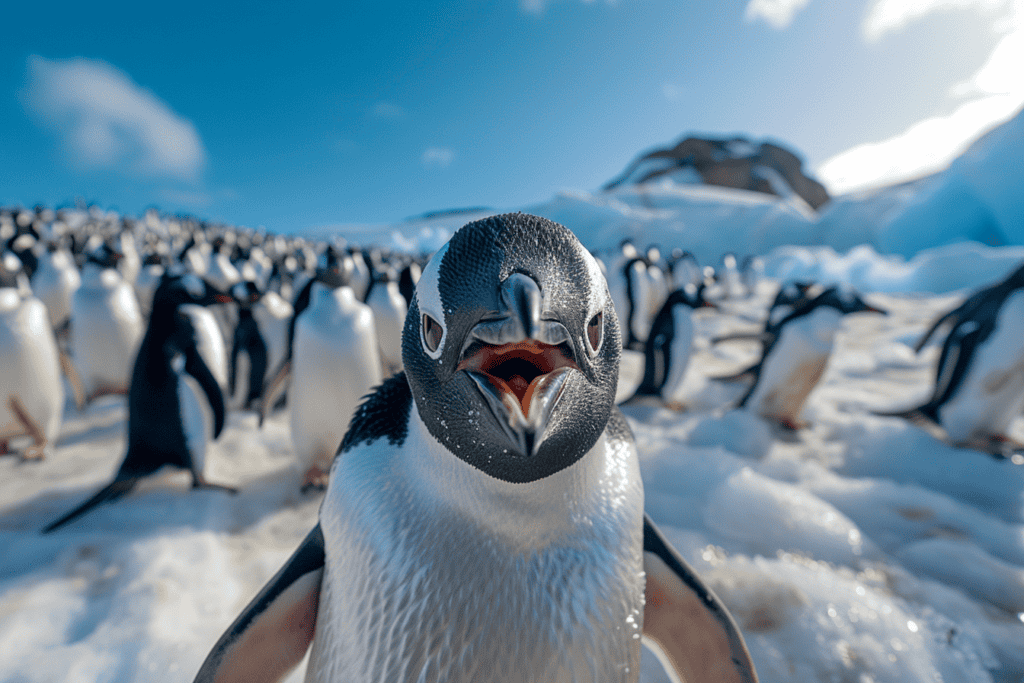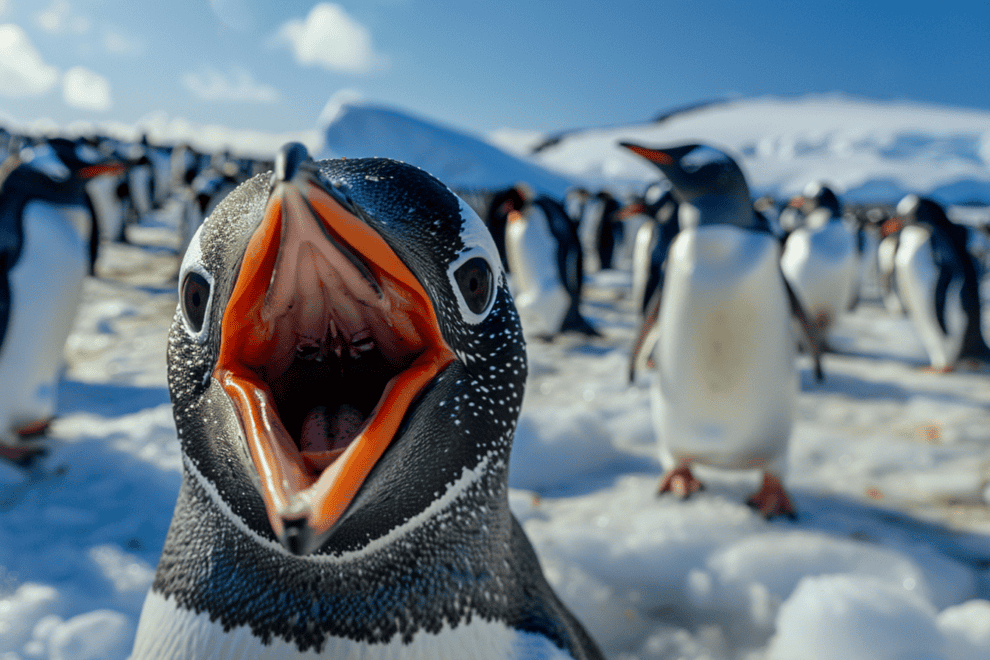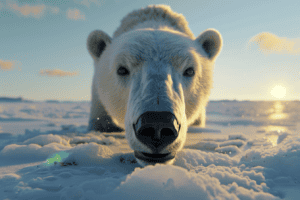Penguins are fascinating creatures. One of the most interesting things about them is their unique adaptation for eating without teeth.
Unlike most birds, penguins do not have teeth. However, they do have serrated ridges on the tops and bottoms of their mouths that help them swallow food.
These ridges are made of keratin, the same material that makes up human hair and nails.

While these ridges may not look like much, they are actually a crucial part of a penguin’s eating process. The ridges help the penguin grip onto slippery fish.
They also assist in breaking down the food into smaller pieces that are easier to swallow. In fact, penguins are able to swallow fish whole, thanks to these serrated ridges.
This adaptation is essential for penguins, as they rely on a diet of fish and other marine creatures to survive.
The Unique Mouth of a Penguin

Unlike most birds, penguins do not have teeth. Instead, they have a specialized beak that is serrated and curved, allowing them to grip and tear their prey with ease.
The backward-facing spines on their beak help them to hold onto their slippery prey, while the sharp edges of their beak allow them to break it down into smaller pieces, making it easier to swallow.
Tongue Twisters: Papillae and Prey
Penguins’ mouths also contain large, distinctive spines called papillae. These papillae coat most of the penguin’s mouth, including the roof and base of the mouth, the sides, and the tongue. Made of soft and smooth keratin, they look like stalagmites and stalactites of a cave.
These serrated needle-like spines have sharp ends, bend inwards, and grow in rows towards the throat. The papillae, along with specialized muscles, glands, and hard cartilage-like ridges, contribute to their feeding efficiency.
These structures assist in manipulating prey, breaking it down into smaller pieces, and swallowing it without losing grip.
Penguins use their tongues to manipulate and position their prey within their mouths. The serrated papillae on their tongue and the roof of their mouth help to hold onto their prey, preventing it from slipping away.
The papillae also serve as a filter, allowing penguins to strain small prey, such as krill, from the water they swallow.
Penguin Life in the Arctic Waters

Penguins are flightless birds that are well adapted to life in the marine environment. The Emperor Penguin, the largest of all penguin species, is found in the Antarctic, while other species of penguins can be found in other regions, such as South America, Africa, and Australia.
Although penguins are not native to the Arctic Circle, they are still fascinating creatures that have adapted to survive in some of the harshest environments on Earth.
One of the most remarkable things about penguins is their swimming ability. Penguins are excellent swimmers and can dive to great depths in search of marine prey.
They use their flippers to propel themselves through the water, while their tail acts as a rudder, helping them to change direction quickly. Their streamlined bodies, covered in dense feathers, allow them to move through the water with minimal resistance.
To survive in the Arctic waters, penguins have developed a range of survival strategies. They have a thick layer of blubber that helps to insulate them from the cold water. They also have a unique circulatory system that allows them to conserve heat.
Blood is pumped from their heart to their extremities, where it is cooled before returning to their core, where it is warmed again.
Feathers, Flippers, and Tails: Penguin Anatomy
Penguin anatomy is also well adapted to life in the marine environment. Their feathers are specially designed to keep them warm and dry.
Penguins have two layers of feathers, a dense undercoat and a layer of longer, waterproof feathers on top. They use their beaks to preen their feathers, spreading oil from a gland near their tail to help keep them waterproof.
Penguins have powerful flippers that allow them to swim through the water with ease. They use their flippers to steer and change direction, as well as to propel themselves through the water.
Their tail acts as a rudder, helping them to turn quickly.
Penguin Behavior and Social Life

Penguins are fascinating creatures that have a unique daily routine. Their day starts with feeding, followed by nesting, and then socializing. Penguins are territorial, and they spend most of their time in their nesting sites, which they fiercely defend against other penguins.
African penguins, for instance, are known for their elaborate courtship displays, which involve bowing, calling, and preening. This behavior is believed to strengthen the bond between the male and female penguins.
After mating, the female penguin lays one or two eggs, which both parents take turns incubating for about 30 to 40 days. During this time, the penguins huddle together to keep warm and protect their eggs from predators.
Once the eggs hatch, the parents take turns feeding and caring for their chicks. Penguins are excellent parents and will go to great lengths to protect their offspring, even if it means risking their own lives.
Communication and Community: The Social Penguins
Penguins are highly social animals and communicate with each other in various ways. They use vocalizations, body language, and even touch to convey information.
Different species of penguins have unique vocalizations, which they use to identify their mates and offspring. For instance, emperor penguins can recognize their mate’s call even in a crowd of thousands of other penguins.
Penguins also use body language to communicate. They will often bow, flap their wings, and preen to show affection or dominance. They also use touch to bond with each other, often nuzzling or cuddling with their mates or offspring.
Despite their social nature, penguins can also be aggressive towards each other. They will fight over food, nesting sites, and mates, often engaging in physical altercations.
Conservation and the Future of Penguins

Penguins are fascinating seabirds that have captured the hearts of people around the world. Unfortunately, many penguin species are facing significant threats to their natural habitat due to climate change. As the Southern Hemisphere continues to warm, penguins are finding it increasingly difficult to survive in their natural habitats.
Emperor Penguins, in particular, are at risk of becoming endangered due to the loss of sea ice. These penguins rely on sea ice to breed and raise their chicks, and as the ice melts, their populations are declining.
Conservation efforts are crucial in protecting penguin populations from further decline. Wildlife organizations are working to establish marine protected areas to conserve important breeding and feeding grounds for penguins. Additionally, research is being conducted to better understand penguin behavior and ecology, which can inform conservation efforts.
It’s important to remember that penguins are not the only species at risk due to climate change. Polar bears and other Arctic animals are also facing similar threats. By taking action to reduce greenhouse gas emissions and protect natural habitats, we can help ensure a brighter future for all wildlife.
Frequently Asked Questions
How do penguins manage to eat their food without having actual teeth?
Penguins are toothless wonders, but they have a unique way of consuming their food. They swallow their prey whole, and their strong stomachs can crush and digest large chunks of meat. Penguins can also store fish, squid, and crustaceans in an expandable throat pouch for many hours until it becomes soft enough to be digested. This adaptation helps them survive in their natural habitat, where food is scarce and competition is fierce.
What adaptations do penguins have in their mouths to help them catch and consume prey?
Penguins have serrated ridges on the tops and bottoms of their mouths that aid in swallowing food. These ridges can be mistaken for teeth, but they are not. They help penguins grip and swallow slippery prey like fish, squid, and crustaceans. The ridges also prevent prey from slipping out of their mouths, ensuring that they get the maximum amount of nutrition from each meal.
Can you describe the appearance and function of the serrated ridges found in a penguin’s mouth?
The serrated ridges found in a penguin’s mouth are like jagged edges that help them grip and swallow their prey. They are not actual teeth, but they serve the same purpose. The ridges are made of keratin, the same material that makes up human hair and nails. They are sharp and pointed, and they work together to hold onto and cut through prey. The ridges also help to break down food into smaller pieces, making it easier for penguins to digest.
Is it true that penguins use their tongues in a unique way when feeding, and if so, how?
Yes, penguins use their tongues in a unique way when feeding. They have a special muscle in their tongue that helps them push food to the back of their mouths, where it can be swallowed whole.
This muscle is called the hyoid apparatus. It allows penguins to swallow large chunks of food without chewing. The hyoid apparatus is also what allows penguins to store food in their throat pouches for extended periods.
What role do the structures in a penguin’s mouth play in their survival in the wild?
The structures in a penguin’s mouth play a crucial role in their survival in the wild. Without teeth, penguins rely on their serrated ridges and hyoid apparatus to catch, grip, and swallow their prey.
These adaptations help them conserve energy and time, allowing them to spend more time hunting and less time chewing. This is especially important in their natural habitat, where food is scarce and competition is fierce.
How does the feeding mechanism of penguins differ from that of other birds that have no teeth?
The feeding mechanism of penguins differs from that of other birds that have no teeth. Unlike most birds, penguins do not have a crop, which is a pouch in the esophagus that stores food before it enters the stomach.
Instead, penguins use their throat pouches to store food. They also have a unique muscle in their tongue, the hyoid apparatus, which helps them swallow large chunks of food without chewing.
These adaptations allow penguins to consume their prey quickly and efficiently, giving them an advantage in their natural habitat.









